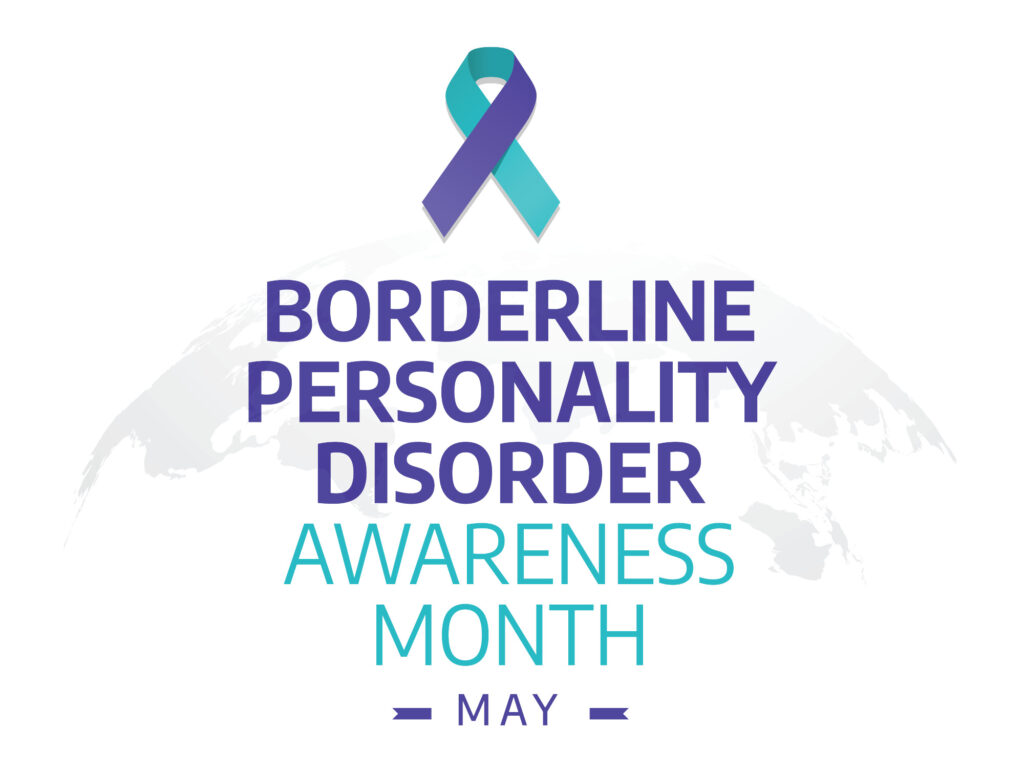In May of 2007, the National Education Alliance for Borderline Personality Disorder (NEABPD) organized hearings before Congress to educate legislators about Borderline Personality Disorder (BPD). A year later, in April of 2008 the U.S. House of Representatives declared May as Borderline Personality Disorder Awareness Month. Below, we’ll dive into the reasons it’s important to know about BPD, and how you can help loved ones with BPD get help.

What is Borderline Personality Disorder (BPD)?
BPD is characterized by pervasive instability in moods, interpersonal relationships, self-image, and behavior. According to the National Institute of Mental Health (NIMH) BPD is:
“A mental illness marked by a pattern of varying moods, self-image, and behavior. These symptoms often result in impulsive actions and problems in relationships. People with BPD may experience intense episodes of anger, depression, and anxiety that can last from a few hours to days.”
BPD typically emerges in adolescence or early adulthood and can persist throughout a person’s life, if left untreated. Researchers are still trying to understand the causes of borderline personality disorder.
Borderline Personality Disorder Facts and Figures to Know
- Research shows that 1.6% of the U.S. population has BPD. That’s over four million people.
- BPD is more prevalent among the inpatient psychiatric population, in which 20% of people have BPD.
- About 75% of people who are diagnosed with BPD are women.
- More people have BPD than schizophrenia and bipolar disorder combined.
- People with BPD commit suicide at 400 times the rate of the general population
- BPD is more common in women than men.
- BPD is associated with a higher incidence of suicide attempts, substance abuse, eating disorders and depression.
- Individuals with BPD have extreme swings in their moods, feelings, behavior and self-image.
- BPD is the 3rd leading cause of death for young adult women between 15-24.
- Women are three times more likely than men to be diagnosed with BPD.
- BPD is treatable, through therapy and medication.
- The average time from the onset of symptoms to diagnosis is 10 years.
- Approximately 50% of people with BPD experience significant improvement in their symptoms within 5 years with treatment.
- BPD often co-occurs with other mental health conditions such as depression, anxiety and posttraumatic stress disorder (PTSD).
Those facts are surprising: 5.9% of the adult population has BPD, they commit suicide at an alarming rate, and women are especially vulnerable to the disorder.
That’s why we have Borderline Personality Disorder Awareness Month. To raise awareness and awareness, end the stigma around the condition, and encourage people to get the help they need. Each year, the National Education Alliance for Borderline Personality Disorder (NEABPD) publishes a blog called “A Post a Day in May” to help people learn more about BPD. Last year’s blog included posts on skills derived from dialectical behavior therapy (DBT), including mindfulness, coping, naming emotions, and distress tolerance strategies.

How to Observe Borderline Personality Disorder Awareness Month?
The best way to observe BPD Awareness Month is by educating yourself about the disorder. Support the people around you who are affected by adult or teen BPD by reading materials written by experts who understand and specialize in this condition.
BPD Awareness Month is a great time to learn more about BPD, to help you develop a greater understanding and compassion for those living with it. Additionally, you can help reduce the stigma surrounding BPD by openly discussing it with family and friends. By doing so, more individuals with BPD can receive appropriate treatments and be surrounded by a supportive network of loved ones, resulting in improved outcomes for your loved ones and community.
Why Is Borderline Personality Disorder Awareness Month Important?
Remember, over four million Americans have BPD, so BPD awareness is crucial. Borderline Personality Disorder Awareness Month is a time to raise awareness about BPD and advocate for the rights of those living with it. Each May, BPD Awareness Month is an opportunity to educate the public about borderline personality disorder facts, reduce stigma surrounding it, and provide access to resources that can help people cope with its symptoms.
How Can I Participate in BPD Awareness Month?
BPD Awareness Month is an important time for everyone to come together and recognize the impact of Borderline Personality Disorder. BPD has been recognized as a mental health condition since the late 1960s and today, millions of people are living with it.
During BPD Awareness Month is a time to spread awareness about this disorder, the dangers, the treatment, and the hope. People can take part in social media campaigns, share helpful resources with their friends, and talk to their local authorities about what more can be done to help those living with BPD.
It is important to recognize the dangers associated with BPD, such as self-harm and the risk of suicide in teens with BPD. By taking action during BPD Awareness Month, we can work together to reduce the stigma of this disorder and provide support to those living with it. It is time to come together to raise awareness and help fight the dangers associated with BPD.
BPD is one of the most misunderstood diagnoses in mental health. It also comes with serious stigma and negative baggage, which shows up not only in the general population, but also among mental health professionals. In the words of Joyce Burland, Ph.D. of the National Association on Mental Illness (NAMI):
“When I started my clinical career, I was warned to “stay away from ‘Borderlines’.” [So] I began to search out information about this dread diagnosis, which was primarily attached to women, and carried with it such a blatantly stigmatizing reputation. As I began working with people with this disorder, I became aware of the enormous strength and resiliency they brought to the daily struggle of coping with the disruptive symptoms of the condition, and of the patience and loyalty shown by the families who loved and supported them.”
Burland offers several possible explanations for the negativity surrounding BPD. First, the wide range of symptoms – all of which are rarely present in one individual – and their overlap with other mental health disorders make it difficult to diagnose. Second, it rarely occurs alone, and is often accompanied by a co-occurring condition such as major depressive disorder, bipolar disorder, substance use disorders, eating disorders, and anxiety disorders. Finally, because of the presence of other mental health disorders, people with BPD are often on several medications – and there is no single medication that has been researched and approved for BPD.
This is unfortunate, because BPD is far more common than most people realize. Here’s a set of facts people should know.

Diving Deeper into Borderline Personality Disorder
Want to learn more about this complex disorder? That’s what BPD Awareness Month is all about!
What Are the Symptoms of Borderline Personality Disorder?
There are nine symptoms commonly associated with BPD:
- Frantic efforts to avoid abandonment, real or imagined
- Patterns of intense and unstable relationships with friends and family, which may manifest as shifting from one extreme relationship state to another, such as:
- Idealization, i.e. extreme love and intimacy
- Devaluation, i.e. extreme dislike or anger
- Impulsive, risky behaviors that may include:
- Substance Abuse
- Reckless driving
- Binge eating
- Spending sprees
- Gambling
- Distorted and unstable self-image, which can affect moods, values, opinions, goals, and relationships.
- Suicidal and self-harming behavior
- Intense mood swings. Mood episodes may last from a few hours to several days
- Chronic feelings of emptiness
- Intense, inappropriate anger that’s difficult to control
- Dissociative feelings such as:
- A sensation of being cut off from one’s body
- A sensation of seeing oneself from outside one’s body
- Stress-related paranoia, which can lead to psychotic episodes
It’s rare to see all the symptoms above in one person. Diagnosis can be tricky, because many of the symptoms above overlap with other mental health disorders. In general, if five of the nine symptoms are present, a therapist may diagnose an individual with BPD. The best way to diagnose BPD is through a comprehensive evaluation by a mental health professional, which includes a thorough assessment of personal and family mental and physical health.

What Causes Borderline Personality Disorder?
Health scientists and researchers have not identified a clear cause of BPD. However, the latest research indicates the following elements may play a role in the development of the disorder:
- Genetics. People with a close relative – a parent or sibling – may be at increased risk of BPD.
- Neurobiological factors. Research shows people diagnosed with BPD sometimes have structural and functional changes in the areas of the brain that regulate emotions and control impulses. Scientists have not identified whether these structural and functional changes are the cause of the disorder, or a result of the disorder.
- Environmental factors. People with BPD often report a history of trauma, such as physical, emotional, or sexual abuse, adverse childhood experiences, or exposure to violence and/or hostile conflicts.
It’s important to understand that not all people who meet the criteria above will develop BPD. Also, people who don’t meet any of the above criteria may develop BPD – that’s one of the reasons it’s a misunderstood disorder. Some experts indicate we’re about twenty years behind on research regarding BPD, as compared to other mental health disorders such as depression, bipolar, and anxiety. Despite this fact, there are effective treatments for BPD.
How Long Do BPD Episodes Last?
People with BPD often experience episodes of extreme emotional distress, called “emotional dysregulation” or “dysregulated episodes”. During these episodes, individuals may feel overwhelmed and out of control, or may behave impulsively and in destructive ways. But how long do BPD episodes last?
The duration of BPD episodes can vary from person to person. For some people, the episode may pass relatively quickly—in a matter of hours or days. Other times, an episode may persist for weeks at a time, even months. It is important to remember that BPD is a highly individualized mental health condition, and the length of episodes can vary depending on a variety of factors, such as stress levels and coping strategies.
Because BPD episodes can be so intense, it is important for those affected to find appropriate treatment and support systems in order to manage their symptoms. Learn more in our guide to BPD.
Is There a High Risk of Suicide in Teens with BPD?
When it comes to Borderline Personality Disorder (BPD) in teens, there is a high risk of suicide. According to the National Alliance on Mental Illness, up to 10% of people with BPD die by suicide. Suicidal thoughts are higher among all teens dealing with mental health issues, such as anxiety, PTSD, partial personality disorder, and depression.
Teens with BPD are particularly vulnerable because they often suffer from intense feelings of loneliness and despair which, combined with their tendency to act impulsively, can lead to self-harming behaviors and suicidal thoughts. As such, understanding how how to manage teen BPD must include understanding the risks and warning signs of suicide.

How to Treat Borderline Personality Disorder
To date, mental health professionals recognize that the best approach to BPD is a comprehensive, integrated treatment plan. It should include psychotherapy, peer support, family support, and in some cases, medication.
- Psychotherapeutic Approaches: Talk therapy is the first-line treatment for BPD. Evidence indicates that Dialectical Behavior Therapy (DBT), Cognitive Behavioral Therapy (CBT), and Mentalization-Based Therapy (MBT) are effective in treating BPD.
- Medication: There are no known medications specifically designed to treat people with BPD. However, people that have BPD and a co-occurring disorder such as extreme anger, anxiety, or depression may be prescribed mood stabilizers, antipsychotics, antidepressants, or anti-anxiety medications.
- Peer and Family Support: People with BPD suffer from intense feelings of loneliness and intense fears of abandonment. They also experience drastic mood swings, and tend to have volatile relationships. For these reasons, having friends and family who understand the condition and are compassionate, patient, and accepting can be crucial.
Twenty years ago, many mental health professionals thought there was little hope that people with BPD could manage their symptoms. Current research, however, shows that treatment can decrease symptoms and improve the quality of life for people with BPD. Talk therapy first, medication if needed, and social support next: that’s the current treatment model. The family/social aspect of treatment should not be downplayed. Friends and family cannot make the emotions go away, but they can offer steady support when the individual diagnosed with BPD is on a rollercoaster of extremely difficult to manage thoughts and emotions.
Finding Treatment for BPD
When seeking professional help for BPD, it’s critical to find a therapist with experience treating BPD. Also – and this should go without saying – any therapist you consider should be fully licensed and accredited. Licensure and accreditation for qualified therapists should be easy to find: if it’s not on their website or their bio, move on to another therapist. The last criteria for finding the right therapist is totally subjective: people seeking therapy should always trust their instincts. If the connection feels right, then trust that. If it doesn’t, then you should keep searching until you find someone you feel comfortable with.
These online resources can you find an effective treatment for BPD:
NAMI’s article “How You Can Get The Right Mental Health Treatment”
Parents of teens can find a qualified professional in their area with this psychiatrist finder provided by the American Academy of Child and Adolescent Psychiatry.
The American Academy of Psychotherapists maintains a helpful therapist finder here.
This BPD Fact Sheet published by the National Education Alliance for Borderline Personality Disorder (NEABPD) contains a wealth of BPD facts, resources, and helpful information for people struggling with BPD or people with friends or loved ones struggling with BPD.
Frequently Asked Questions About Borderline Personality Disorder Awareness Month
What color represents BPD Awareness Month?
The color associated with Borderline Personality Disorder (BPD) awareness and May’s annual BPD Awareness Month is typically represented by a combination of orange and teal.
What are the types of BPD?
BPD is not typically categorized into distinct types, but it may present with various patterns of symptoms and behaviors, including impulsive, emotionally unstable, avoidant, and self-destructive tendencies.
What does a BPD episode feel like?
During a BPD episode, individuals may experience intense emotional dysregulation, characterized by extreme mood swings, impulsivity, fear of abandonment, distorted self-image, and difficulty maintaining stable relationships.
What are some misconceptions about BPD?
Misconceptions about BPD often include stigmatizing beliefs about manipulation, attention-seeking behavior, and the idea that individuals with BPD cannot recover or improve. BPD Awareness Month and year-round awareness efforts seek to dispel common misconceptions and stereotypes about BPD.
What are some self-care strategies for individuals living with BPD?
Self-care strategies for individuals with BPD may include practicing mindfulness, engaging in healthy coping mechanisms, setting boundaries, and seeking support from trusted individuals.
Can BPD be diagnosed in children?
BPD is typically diagnosed in adulthood, but symptoms may begin to manifest in adolescence. In children, symptoms of BPD are often difficult to distinguish from typical developmental challenges, so diagnosis and treatment can be complex.
Is BPD the same as bipolar disorder?
No, BPD and bipolar disorder are distinct mental health conditions. BPD primarily involves difficulties with emotional regulation and self-image, while bipolar disorder is characterized by episodes of mood swings ranging from depression to mania.






